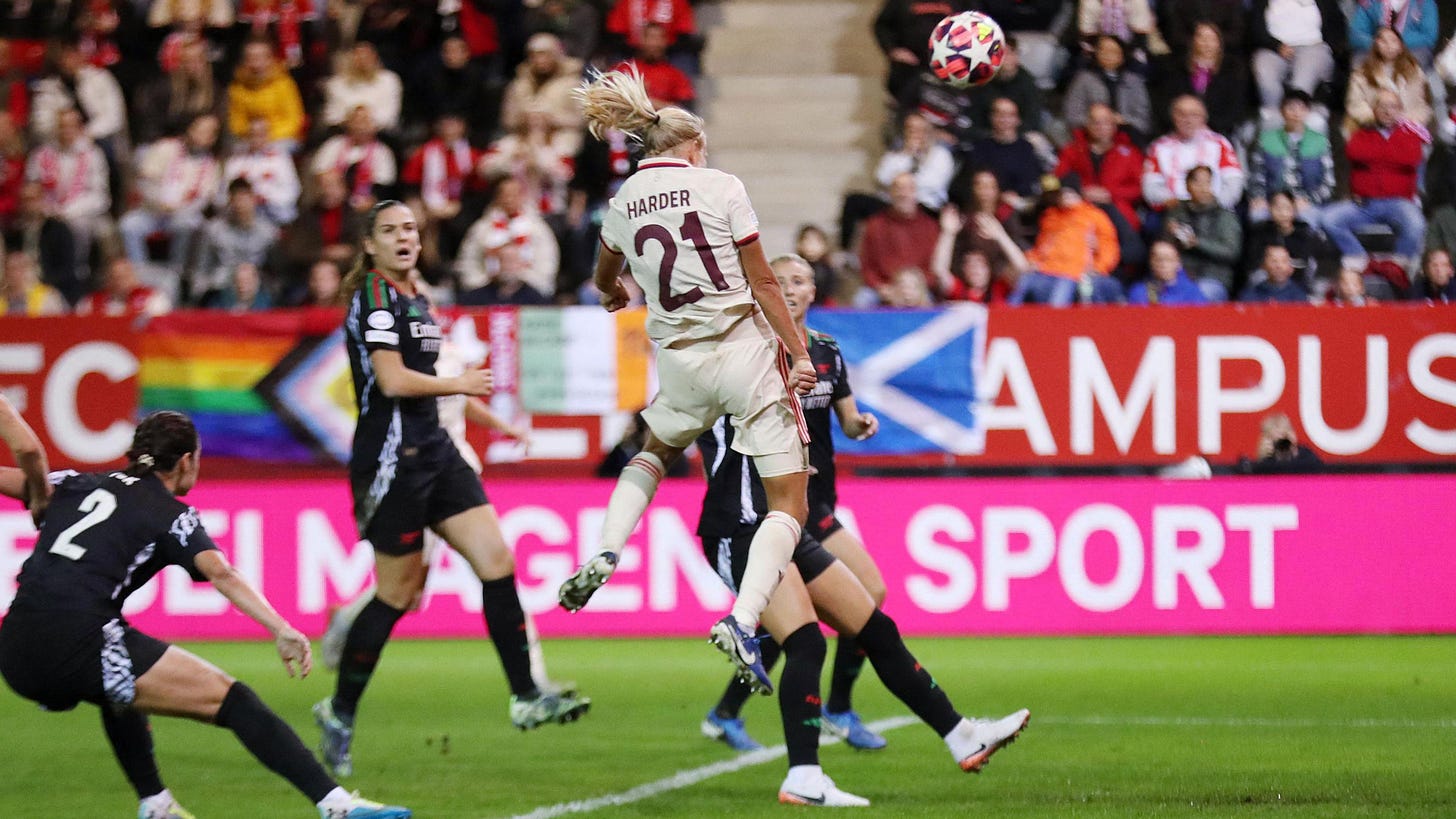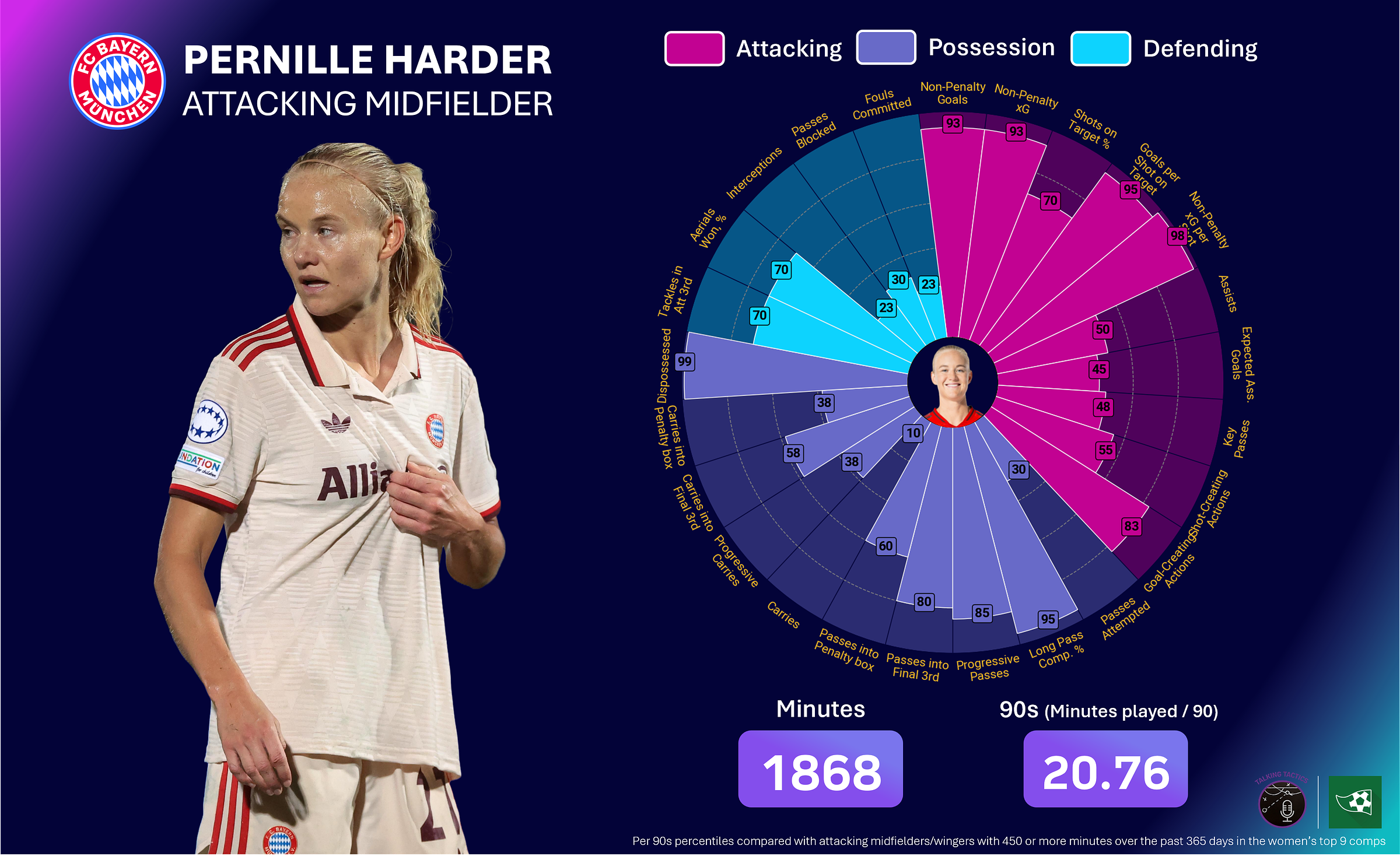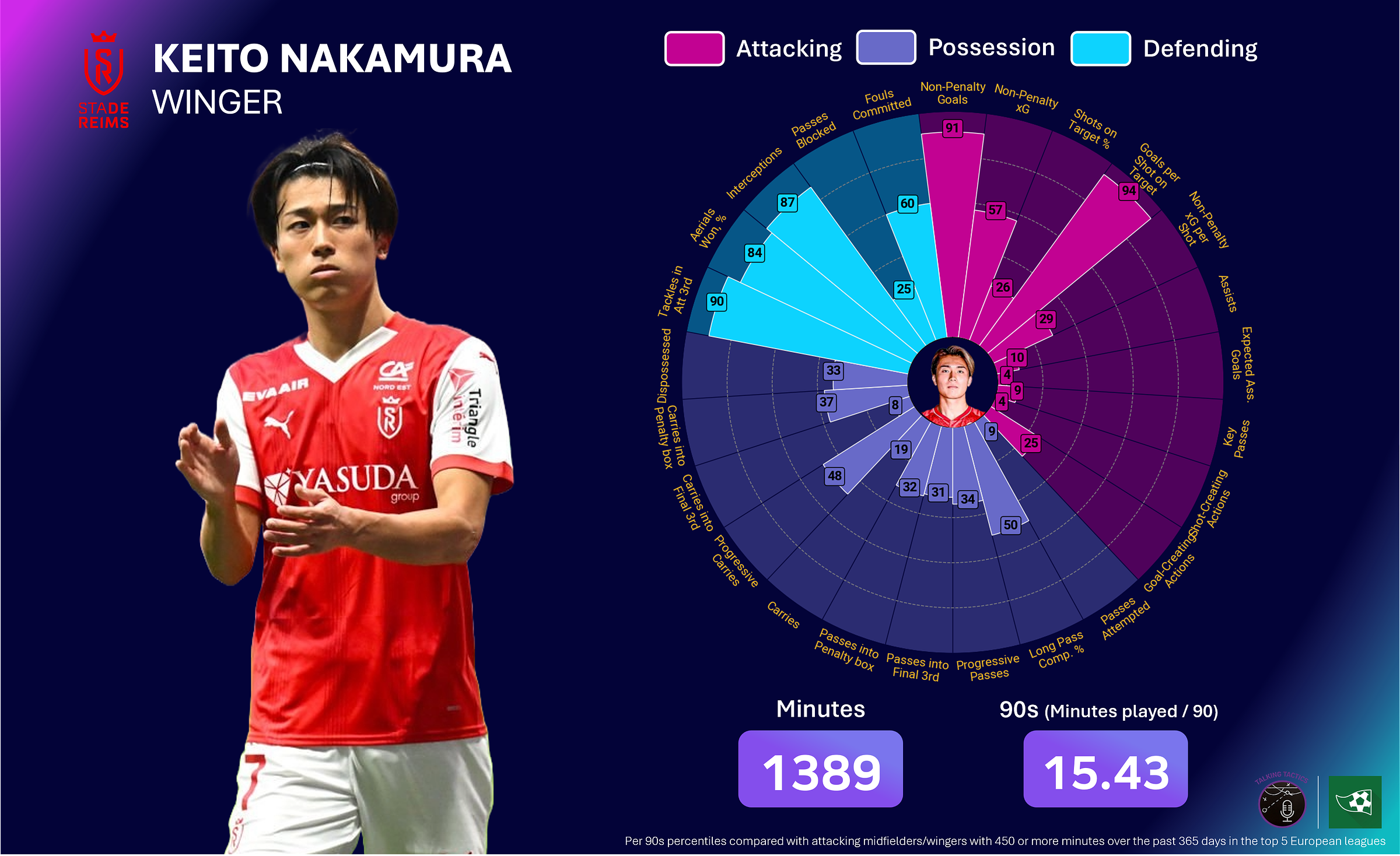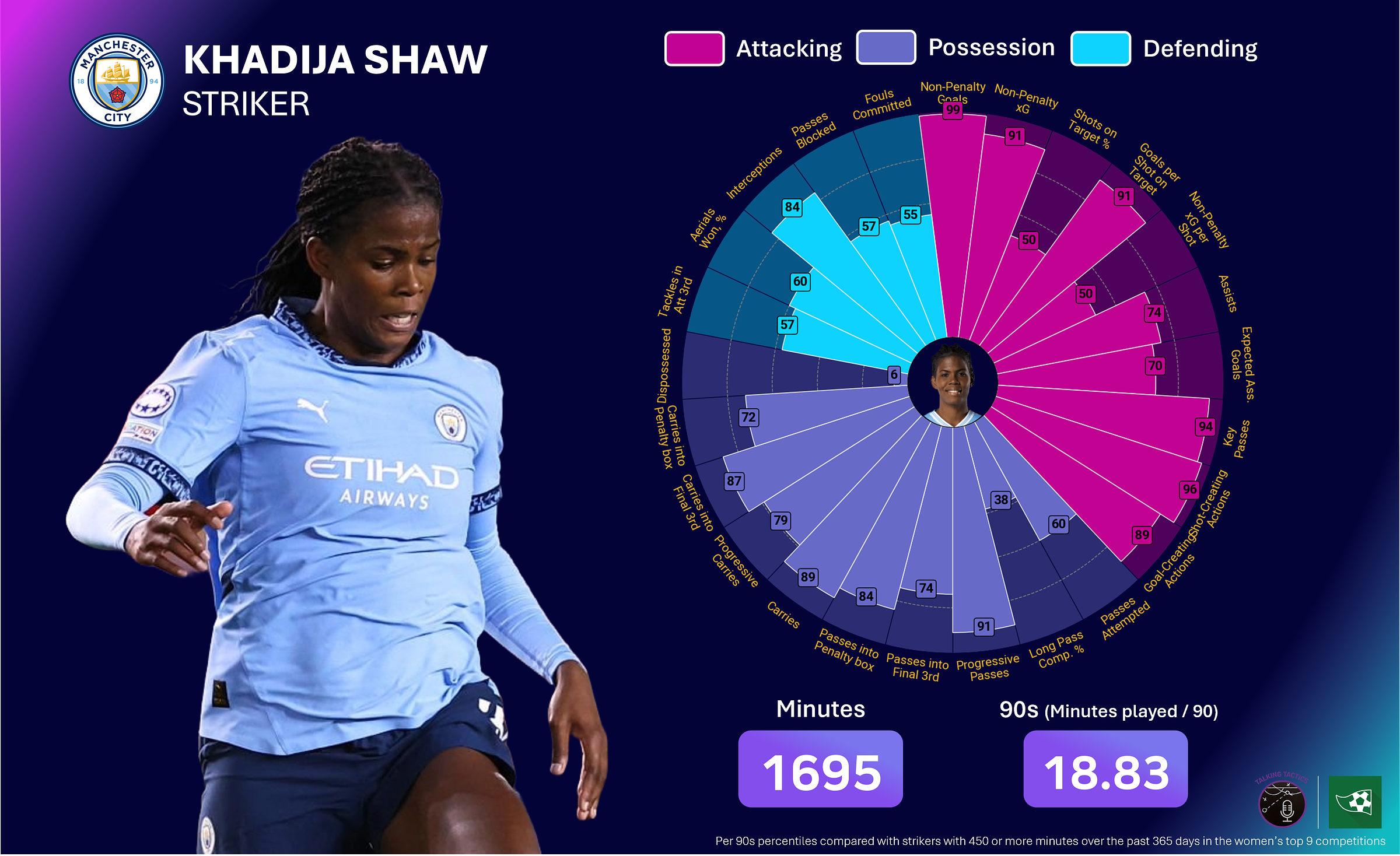Daryl's Notebook: The Scouting edition (Part 2)
Three players scouted, three more to go! Let's shine a spotlight on attackers in this edition.
After shining a spotlight on underrated defenders and midfielders who stood out in the Champions League and Ligue 1 in Part 1, let’s move up the pitch and focus the attacking midfielders and strikers who caught my attention in previous editions of the Notebook. You can find Part 1 of this two-part Scouting edition here, but let’s not wait anytime and start scouting!
Note: FBRef’s data were recorded and were accurate as of October 18th.
Pernille Harder (Bayern München)
For avid women’s football followers, Pernille Harder should be a very familiar name as the Danish player has developed a reputation for being a goal-scoring machine at Chelsea. It seems as if that reputation has not died down after Harder’s move to Bayern either. In Bayern’s opening match in the Women’s Champions League against Arsenal, Harder pulled off a masterclass with a hat-trick within the second half and pulled the German side from an evenly-matched first half to a comfortable win in the second half.
One of the things that stood out to me from that match (and also from Bayern’s second match against Juventus; in an unreleased edition of the Notebook) was Harder’s off-the-ball movements and runs. There was a tendency to find channels that were left vacant by the opposition’s defenders and Harder would station in those sort of spaces, where it was possible to then make runs in behind to receive a through ball or a long ball over the top. Physicality also played an important part as it allowed Harder to brush off the pressures from the opposing defenders and create a clean-through situation to face the goalkeeper, or to win aerial challenges from crosses coming in from both wings. This allowed the Dane to be in good goal-scoring positions, which explain the high goal-scoring level at both Chelsea and Bayern.
Defensively, Harder showed a willingness to work hard for the team and stay discipline in a defensive block. Both when Bayern were defending in a mid-block against Arsenal and when they counter-pressed against Juventus, Harder utilised the reading of the game to detect potential passes and passing lanes that could come through Bayern’s defensive block and attempted to block them before they could be opened. Bayern’s #21 also worked hard in counter-pressing situations by applying pressure on the opposition’s ball carrier and forced a quick turnover right inside their own defensive third.
Once again, we will be using the observations from Bayern’s first two Champions League matches and see if the data from FBRef agrees with those observations. While women teams play less matches than men teams, the sample size is still very significant to make accurate assumptions about Harder’s performance over the past year.
Even though there is no need for more confirmation that Harder is a great goal-scorer, the data still captures that greatness through its percentiles. 93rd for non-penalty goals, 93rd for non-penalty xG, 95th for goals per shot on target, and 98th for non-penalty xG per shot are all outstanding numbers and paint an accurate picture of a lethal goalscorer who achieves high efficiency in front of goal and might overperform expected numbers for a bit.
But Harder’s style of play is so much more than being an out-and-out #9. Even though the percentiles for chance creation do not stand out very much, they still highlight Harder’s ability to create chances for teammates and contribute to the team’s build-up play. 50th for assists, 55th for shot-creating actions, 83rd for goal-creating actions, 85th for progressive passes, and 80th for passes into the final third still put Bayern’s #21 up there as one of the best complete forward of women’s football this past few seasons.
In contrary, the data also shows that the Danish striker is not the type of striker who can dribble with the ball as Harder is ranked 10th for carries, 38th for progressive carries, and 38th for carries into the penalty box. As highlighted from the observations in Bayern’s matches against Arsenal and Juventus, Harder preferred to be on the opposite end of where the action area was while also finding space and channels to move into. Once inside the final third, Harder became a lot more dangerous through the off-ball runs into the penalty box to be at the end of crosses that came in from both flanks. This was exactly how the Dane scored Bayern’s fifth goal against Arsenal.
Unarguably one of the best strikers in women’s football right now, Harder will only become better and better as time goes on. The main task for Bayern, however, is to utilise Harder’s ability to its fullest and build a team that can challenge and, potentially, win the Frauen-Bundesliga and the Champions League to prove their stance in the world of women’s football.
Keito Nakamura (Stade Reims)
Since joining Reims from LASK in the Austrian Bundesliga, Keito Nakamura has taken Ligue 1 by storm with his directness and pace out on the wings. Along with his fellow compatriot, Junya Itō, they are leading Reims to new heights under Will Still in past seasons and now with Luka Elsner. And against Montpellier in Ligue 1, we were able to see some of that directness in Nakamura’s runs down the left-hand side as he contributed massively to Reims’ 4-2 win at home.
The Japanese international gave Montpellier’s right-back Falaye Sacko a tough time by constantly taking him on in 1v1 situations and used his technical skills to get pass Sacko. Nakamura’s pace also made it harder for Sacko to catch up once he was bypassed. Once Nakamura found himself dribbling towards the byline, he would sometimes attempt a cross into the box to find Oumar Diakité, who had the physicality to head the ball home. Another option that Nakamura also preferred was to cut inside on his right and found an opportunity to take a shot from the edge of the box. He can score from long shots, and Nakamura used such ability well to struck the ball home for Reims’ second goal of the day.
Defensively, Nakamura also showed that he can work hard for the team either when they dropped back into a mid-block or they attempted to press the opposition inside their own defensive third. When the ball was played to his side of the pitch, the Japanese player would close the ball carrier down while tried to be aggressive with his challenges to regain possession. If the opposition attempted to play through Reims’ defensive block, Nakamura used his positioning to cut the available passing lanes and, at times, intercepted passes that came into the block to start a quick counter-attack.
Combining the observations above with Nakamura’s data from FBRef and we can see that Nakamura fits perfectly into the profile of a traditional inverted winger. The sample size also supports the observations since he has played a total of almost 1400 minutes over the past year and accumulated 15.4 90s.
While not attempting too many carries (19th for carries) and take-ons (13rd for take-ons attempted), the Japanese winger still shows a tendency to look forward whenever he attempts a dribble and bring the whole team forward, especially in counter-attacking situations. This is reflected through his percentile rankings of 48th in progressive carries and 37th in carries into penalty area. What Nakamura stands out the most, is his goal-scoring ability from out wide as he ranks 91st for non-penalty goals, 94th for goals per shot on target, and 97th for non-penalty xG overperformance, which he uses to make up for not being an outstanding dribbler.
His defensive ability is also reflected on the data with his 90th ranking for tackles in the attacking third and 87th in interceptions. It is an attitude that can work very well in teams that like to press as his reading of the game can help Reims regain possession through interceptions or forced turnovers. It is also surprising to see that Nakamura is ranked 84th for aerial won percentage, highlighting that the Japanese winger can also use his physicality to win long passes coming towards him.
Reims are currently flying in Ligue 1 and a decent part of that rise up the table is the dynamic winger duo of Itō and Nakamura. Nakamura, specifically, has shown that he can be a valuable asset for any team as his dribbling ability can help driving the team forward. He can also be a decent goal-scorer from out wide with his long shots and curve shots from outside of the box. While it can be hard to imagine Nakamura playing in the Premier League, it is definitely possible for him to follow the footsteps of his fellow compatriots and secure a move to England.
Khadija Shaw (Manchester City)
Similar to Harder, Khadija Shaw has also developed a reputation as one of the best goal-scorers in women’s football, but also contributing to other aspects of the team’s play. Now at Manchester City, the Jamaican international is playing in a team that are developing season after season in…Man City’s style. They have shown that they could compete against the biggest teams in European football after a very strong showing against Barcelona at home to secure a 2-0 win.
In that match, Shaw put on a show in the role of a complete forward as Man City’s #21 acted as the focal point for the host’s attacks. Passes were played towards Shaw as the Jamaican would hold up the ball for teammates to move forward and provide support, while also provided opportunities to create chances for others. Shaw had the physicality to both hold off challenges from Barcelona defenders and made runs in behind the opposition’s defence to pick up long passes and through balls, which happened on a fair few number of occasions throughout the match, and also led to Man City’s second goal of the night.
While not the most active player defensively, Shaw still remained a crucial part in City’s defensive shape. The Jamaican striker led the team to press Barcelona inside of their own half and would attempt to position at the right place to cut passing lanes and intercept passes. Physicality also helped, especially in counter-pressing situations, as Shaw would attempt to regain possession quickly after losing it by outmuscling the opposition’s defenders and midfielders. On a few occasions, Shaw also put Barcelona keeper Cata Coll into some nervous situations too by executing the press directly in Barcelona’s own penalty box.
As per usual, data from FBRef will be used here to support the observations made from the Champions League match while also providing a better look at Shaw’s performance over 1695 minutes of the past year. The sample size is also very significant for better and more accurate observations, which is always a good thing.
With a 99th percentile for non-penalty goals, 91st percentile for non-penalty xG, and 91st percentile for goals per shot on target, Shaw also needs no more confirmation that the Jamaican international is an outstanding goalscorer. At this point, it will feel like I am repeating my thoughts about Harder, but it is because their goalscoring percentiles are very similar and both highlight someone who can be very lethal in front of goal and can score from a chance with low probability of scoring.
What’s more is that Shaw’s data also accurately show the ability to create chances for other teammates as Man City’s starting striker is ranked 74th for assists, 94th for key passes, 96th for shot-creating actions, 89th for goal-creating actions, and 91st for progressive passes. If creating chances for others is not an option, Shaw can still take a chance by dribbling and carrying the ball, with the percentile rankings of 89th for carries, 87th for carries into the final third, and 72nd carries into the penalty box reflect that. These percentiles show a multi-facet striker who can create chances from almost anywhere and for anyone in the team, either for others or take that chance single-handedly.
Shaw might not stands out in terms of defensive percentiles, but most of those percentiles still rank above the 50th mark, indicating that Shaw still contributes to the team’s defensive work at a decent level. What stands out is the 80th ranking in interceptions, which highlights the Jamaican striker’s ability to read the game well to intercept passes and regain possession for Man City. Usually these situations will come inside of the opposition’s half, which will be very dangerous for the opposition considering Shaw can create chances very well.
Another striker who is also a complete package for their team, Shaw is being used as an out-and-out #9 for Man City and they are maximising what the Jamaican can do. Offensively, the team benefit by Shaw’s goal-scoring and chances creation ability, while defensively, Shaw brings a willingness to press and regain possession to help the team play with a high-intensity pressing style. There is no doubt that Man City will be relying on Shaw if they want to win the Women’s Super League as they start to aim for new heights, which includes lifting the Champions League title.







